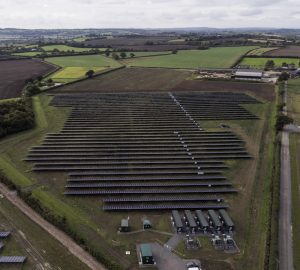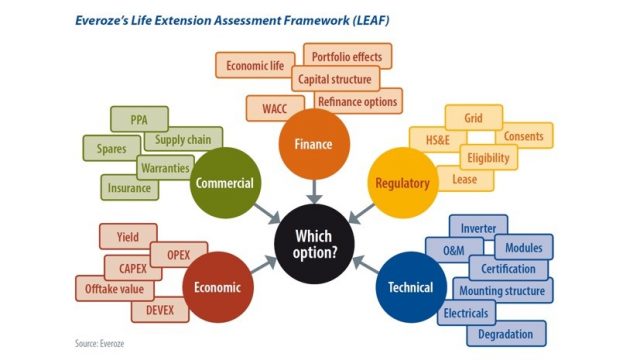Green shoots of recovery
Article by Adam Sharpe, published in PV Magazine 12th December 2019
There has been significant progress in the decarbonisation of the electricity supply in Great Britain in recent years, underscored by a record run of 19 days of zero coal generation in May and June 2019. With National Grid’s stated aim of operating a carbon-neutral electricity system by 2025, the co-location of PV with battery storage could play a key role. The proposition offers the twin benefits of enabling increasingly high renewables penetration while simultaneously improving network stability. Adam Sharpe of Everoze explores the role of co-located PV and energy storage assets within the context of the UK’s future decarbonisation plans.

Image: Anesco
Fuelled by the availability of generous subsidies in the decade leading up to 2017, PV arrays delivered healthy returns in Britain, especially to early movers. In turn, this kick-started substantial investment in the sector and resulted in the installation of total PV capacity exceeding 13 GW. But the post-subsidy investment landscape, with its inherent exposure to merchant prices, has been challenging, and has led to a period of relative stagnation. Yet the green shoots of recovery are now evident, as wide-scale deployment of PV globally continues to yield further capex reductions. Recognising this trend, PV developers continue to speculate on site identification and development, as evidenced by a nation-wide pipeline for new PV in excess of 5 GW.
Progress in battery storage system deployment has been similarly tempered, after an initial explosion driven by the availability of several revenue streams combining to deliver a viable business case. Such revenue streams include frequency response and capacity contracts, and “embedded benefit” payments that offer revenue to the generator by virtue of being connected to the distribution network rather than the transmission network. As a result, around 700 MW of battery storage systems are currently in operation within Great Britain.
However, increasing competition for grid service contracts and the mixed picture presented by the current policy and regulatory landscape have stalled further deployment. Market regulator Ofgem has come under heavy criticism for its position on the Targeted Charging Review, which would remove many of the embedded benefits received by distribution network-connected storage. This move has been seen by the industry as contrary to its stated policy goals. Against this, a number of regulatory reforms are in progress to remove barriers to the deployment of storage.
Proposed changes to national planning legislation, which would see storage removed from the 50 MW threshold for “Nationally Significant Infrastructure Projects,” present a welcome opportunity for larger-capacity projects to come forward.
21st-century challenges
In the background, the impacts of the increased penetration of variable renewables on the grid is causing some challenges for network operators. The changing pattern of electricity consumption, combined with this increasingly variable generation mix, requires new methods of grid management to maintain a secure and stable electricity network. Measures deployed to date include an increase in reserve generation capacity and fast-acting frequency response.
With these challenges becoming a priority, a number of distribution network operators now offer “flexible grid connections,” which do not provide the generator with a fixed export capacity. This means that ability to export is limited by the balance of supply and demand of the network at any given time. The new framework can lead to increased curtailment risk, reduction of project revenues, and risks to the stable returns required for low-cost project financing.
The impact of changing system dynamics is also felt within the wider electricity market. On May 26, a record-breaking period of nine hours of negative power pricing occurred, breaking the previous record of six hours set just two months earlier. Data from Elexon, the body responsible for managing the energy price settlement process in the British market, indicates that both the frequency and severity of such periods is increasing. Without the protection of stable PPA revenues, new renewable generators are exposed to such volatility.
Technically proven
The technical case for co-locating solar with battery storage is increasingly attractive. The addition of storage opens up new opportunities to maximise revenue by time-shifting output from periods of low to high market pricing, and enables projects to ride through periods of constrained grid capacity, insulating owners from the effects of network constraints and negative market dynamics. Storage can also allow a project to participate in the ancillary grid services markets. Thus, with the aid of storage, solar becomes a better “grid citizen” – helping to provide the network with the additional security required to accommodate even higher levels of solar deployment.
Feedback from some of the initial battery storage installations in Britain has been positive. With careful consideration of the alignment of technical specifications to operational strategy, and appropriate O&M provisions to prevent premature degradation through overuse, operational projects are reporting high availability and good technical performance. As the industry incorporates the lessons learned from the first wave of installations, teething troubles associated with commissioning procedures for battery installations are unlikely to affect future installations.
Looking to the future
In spite of the regulatory reforms mentioned above, the overall direction of policy is still broadly favourable to energy storage. New revenue opportunities are expected to emerge in the future due to increased service procurement by the network operators. The challenge for investors is to find the right combination of revenue streams that allow for efficient battery utilisation, while maximising revenue from solar. This is not a trivial task and requires careful consideration of battery power and energy capacity during the design phase, in addition to the scoping of an operational strategy that does not lead to premature degradation of the battery. These design decisions have material impacts on capex and opex, making this a challenging techno-economic optimisation problem. Successful navigation of these difficulties could mobilise the capital required to kick the British market back into life and enable widespread deployment of co-located systems.
Whilst forecasting and predicting battery system revenues and future power price curves remains an area of uncertainty for infrastructure investment, it’s clear that the technical drivers for co-location are here to stay. With equipment costs for both PV and batteries continuing to decline at impressive rates, it feels like it’s only a matter of time before the financial case for co-location becomes just as compelling as the technical one.






